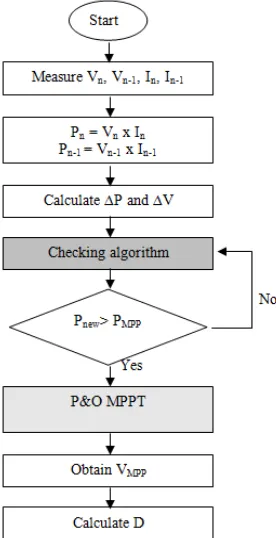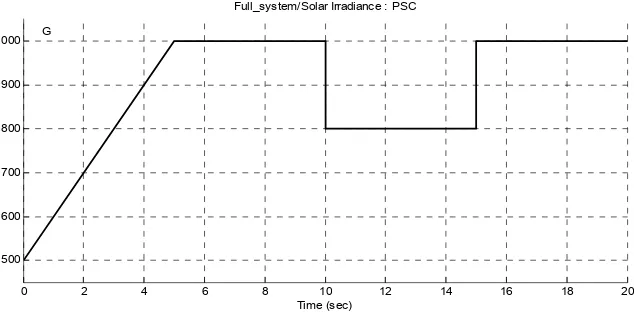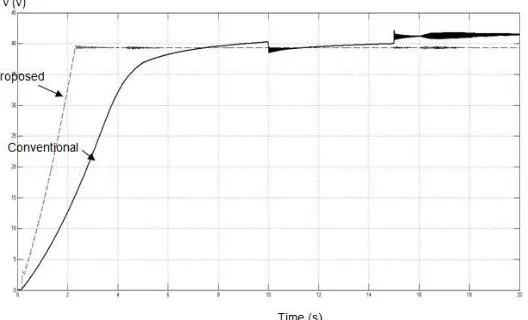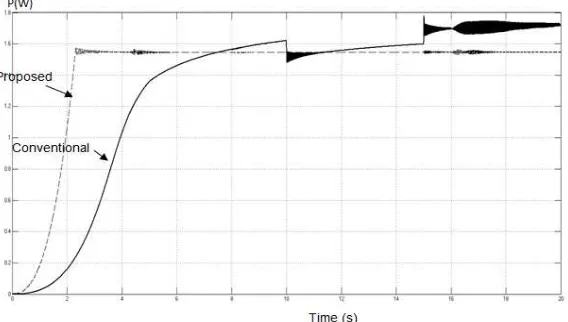DOI: 10.12928/TELKOMNIKA.v14i1.1356 14
A Simple Checking Algorithm with Perturb and Observe
Maximum Power Point Tracking for Partially Shaded
Photovoltaic System
Rozana Alik*1, Awang Jusoh2, Tole Sutikno3 1,2
Department of Electrical Power, Faculty of Electrical Engineering, Universiti Teknologi Malaysia 81310 Skudai, Johor, Malaysia
3
Department of Electrical Engineering, Faculty of Industrial Technology, Universitas Ahmad Dahlan, Yogyakarta 55164, Indonesia
*Corresponding author, e-mail: [email protected]
Abstract
This paper presents a simple checking algorithm for maximum power point tracking (MPPT) technique for Photovoltaic (PV) system using Perturb and Observe (P&O) algorithm. The main benefit of this checking algorithm is the simplicity and efficiency of the system whose duty cycle produced by the MPPT is smoother and changes faster according to maximum power point (MPP). This checking algorithm can determine the maximum power first before the P&O algorithm takes place to identify the voltage at MPP (VMPP), which is needed to calculate the duty cycle for the boost converter. To test the effectiveness of the algorithm, a simulation model of PV system has been carried out using MATLAB/Simulink under different level of irradiation; or in other words partially shaded condition of PV array. The results from the system using the proposed approach prove to have faster response and low ripple. Besides, the results are close to the desired outputs and exhibit an approximately 98.25% of the system efficiency. On the other hand, the system with conventional P&O MPPT seems to be unstable and has higher percentage of error. In summary, the proposed method is useful under varying level of irradiation with higher efficiency of the system.
Keywords: maximum power point tracking, perturb and observe algorithm, solar energy, solar photovoltaic, checking algorithm
Copyright © 2016 Universitas Ahmad Dahlan. All rights reserved.
1. Introduction
Development of alternative energy is rapidly growing around the world. Because of the increase in usage of natural energy, the world faces problems of depletion of natural sources such as petroleum and coal. Therefore, many efforts are being made in finding the most suitable and best way of preserving the natural source.
Most researchers nowadays focus on upgrading the efficiency of the solar power conversion, lowering the cost of photovoltaic (PV) systems, as well as improving the reliability of the PV systems. The efficiency of solar cells can be affected by many factors such as temperature, insolation, spectral characteristics of sunlight, PV array’s degradation and shadow [1].
Maximum power point tracking (MPPT) technique is one of the methods used to increase the efficiency of the PV systems, where it functions to extract the maximum available power from the PV arrays so that the systems can operate at optimum condition. There have been more than 19 distinct MPPT techniques introduced by researchers [2]. Reference [3] stated that fixed duty cycle is the easiest offline method that can be used as it does not require any feedback implementation. However, if there are changes in the operating environment, the efficiency will be low.
In the meantime, some researchers suggest the use of some soft computing based method such as Artificial Neural Network (ANN) and Fuzzy Logic Control (FLC) [6-9]. These methods can assure a good performance and can perform well in various atmospheric condition, besides not requiring accurate mathematical modelling. Nevertheless, the effectiveness of these methods depends on the user knowledge. The users must have background knowledge about PV arrays study to get optimization use. Particle Swarm Optimization (PSO) is an advance technique used by researches [10-12]. It gives great performance in any condition compared to the others but the method is too complex and expensive for domestic use.
The most common approach to find MPP is using Perturb & Observe (P&O) algorithm [13-19]. The technique is simple and requires low cost for implementation. The method operates by detecting the output power of the PV array. P&O operates stage by stage for perturbing and compares the output power by applying the perturbed voltage to change the operating voltage of the PV array. However, the conventional P&O MPPT has lots of flaws, especially when the sun irradiation is not uniform. This causes inefficiency of the PV system. Nevertheless, in this research, P&O algorithm has been used as the MPPT of the system, with some adjustments made to increase the efficiency, as will be elaborated in the next section.
2. Partial Shading Condition
Partial shading condition is one of the crucial issues in PV systems. The irradiance level becomes inconsistent when part of the sun ray is being blocked by the cloud, trees or nearby buildings [20-24]. The shaded cells may get reversed bias; producing high resistance which consumes more power and consequently reduces the load current, IL.
In addition, this condition would exhibit multiple local MPP and cause nonlinearity to the PV curve. The conventional P&O MPPT would undergo some confusion to track the true MPP for the PV system to operate at optimum condition. Figure 1 shows more description on the partial shading condition.
Figure 1. PV curve under uniform and non-uniform irradiation
The normal operation of P&O MPPT is perturbing to the next voltage based on the last sign of increment of power until the MPP is reached. In the other words, as the power increases, the next perturb voltage will increase. Once the power decreases, the perturb voltage will start to decrease. For normal condition, the tracking process would not have any problem since there is only one peak, as shown in the figure. However, for the varying level of irradiation, the P&O MPPT would most probably be trapped at the first MPP, which is around 12V, due to the basic operation of the P&O MPPT.
converter. Reference [24] proposed a drift free P&O MPPT using direct ratio control technique with SEPIC converter on the system. There is also an innovative idea from reference [6] which includes a checking algorithm to search the real MPP. The proposed system consists of a PV array and grid-connected PV inverter. In short, the basic idea of these three methods is to use an extra checking condition in the traditional P&O algorithm to improve the performance of the MPPT. The conventional P&O MPPT would not operate well under different level of sun irradiation until it has been modified.
3. Proposed Modified P&O MPPT
As mentioned earlier, partial shading condition would contribute to multiple maximum power point (MPP). The idea for the proposed method originates from the previous works by other researchers. The difference of the proposed method with the three previous mentioned methods: it was much simpler, by which a checking algorithm is added to the P&O algorithm that can track the real MPP first, as presented in Figure 2. The proposed system was connected to the boost converter which will be described in detail in the next section.
Figure 2. Proposed Modified P&O MPPT with checking algorithm
The checking algorithm is simply comparing the power, Pn with the previous power, P
n-1. If Pn-1 is larger than Pn, the value of Pn-1 will be chosen and compared again with the next power.
Eventually, the largest value of power will be chosen as the MPP for the algorithm. Then, the voltage at MPP (VMPP) can be tracked easily based on the tracked global MPP by using smaller step size for better accuracy. Once the VMPP has been tracked, the duty cycle will (D) be calculated using the boost converter equation:
D = 1-(Vin / Vout ) (1)
to be between 0.1 and 0.8. A simulation using MATLAB/Simulink was done to test the proposed algorithm.
4. Simulink Model of Photovoltaic System
For simulation in this study, the full system consisted of 36 series solar cells, proposed MPPT algorithm, boost converter and resistor as the load, as shown in Figure 3. Boost converter was chosen for the system due to its simplicity, higher accuracy and cost saving. The switching frequency for the boost converter was 30000 Hz while the value for inductor and capacitor used were 16mH and 375µF, respectively. A 1000 Ω of resistor was used as the load for the system.
Figure 3. Simulink model for photovoltaic system
Meanwhile, the irradiance was varied with time, as shown in Figure 4. The values for the solar irradiance were chosen based on the previous works by other researchers. The irradiance was set up for the photovoltaic system to undergo the partial shading condition. The aim of this study was to verify the efficiency of the output at the load side, current, Iout, voltage, Vout, and power, Pout under varying level of solar irradiation.
Figure 4. Solar Irradiation versus time
5. Results and Discussions
This purpose of this paper is to present comparison and discuss the results from the two methods of conventional P&O and proposed checking algorithm with P&O. It is known that the voltage and current produced by the solar module, as well as the duty cycle needed by the boost converter, are affected by the solar irradiation. Different level of irradiance will cause nonlinearity to the PV curve as well as varying the MPP.
0 2 4 6 8 10 12 14 16 18 20 500
600 700 800 900 1000 G
Figure 5. The results of D produced by two distinct methods
It can be seen that the conventional P&O MPPT produced almost a constant D, at 0.5, which then slightly decreased within 10 to 15 seconds. This might be due to the abrupt change in the irradiance level, from 1000 W/m2 to 800 W/m2. In the meantime, the proposed checking algorithm depicted a better duty cycle; it changed instantly according to the changing irradiance.
Figure 6(a). Output current at the load side
Figure 6(c). Output power at the load side
From the results obtained for the duty cycle, it can be expected that the output current, voltage and power would also be different if applied on the three distinct algorithms. The boost converter will operate according to the given D from the MPPT and also the input voltage from the PV array. The results for the Iout, Vout and Pout for two methods (conventional and proposed) are presented in Figure 6 (a), (b) and (c).
It was shown that the proposed checking algorithm of P&O algorithm gave a faster output response, whose system started to be in steady state at 2.1s, compared to the conventional P&O algorithm, whose time to be in steady state started at 6s. Besides, the proposed method provided lower ripple response than the conventional method. As mentioned earlier, the desired voltage for the boost converter was 40V. From the obtained results (Figure. 6 (b)), it can be seen that the voltage produced by the system with proposed checking algorithm was nearly 40V. It was different from the system with conventional P&O algorithm, which produced inconsistent voltage and apparently not equal to the required voltage. This happened because of the major drawback of the conventional algorithm-unable to track the true maximum power point (MPP) as it had been influenced by the different level of irradiation. In contrast, the proposed method for the MPPT system has proven that in any level of irradiation, the MPP can still be tracked and produce the needed output for the system.
4. Conclusion
The photovoltaic system is highly affected by the partial shading condition, which is one of the crucial issues in harvesting solar energy. Numerous techniques have been proposed and elaborated extensively by researchers to tackle the partial shading issue, but most of the methods are complex and costly. The obtained simulation results have verified that the proposed technique-a simple checking algorithm for Perturb and Observe (P&O) Maximum Power Point Tracking (MPPT) - can be used under several levels of irradiation effectively. The obtained results from the system with the proposed approach are close to the desired output. It gives approximately only 1.75% of error, thus has 98.25% system efficiency. On the other hand, the system with conventional P&O MPPT seems to be unstable and has higher percentage of error. In short, the proposed technique is a simple and inexpensive method with only addition of a checking algorithm into the P&O MPPT, yet gives a better result for the system.
Acknowledgement
References
[1] Kabir S, Bansal R, Nadarajah M. Effects of partial shading on Photovoltaic with advanced MPPT scheme. Power and Energy (PECon), 2012 IEEE International Conference on, IEEE. 2012: 354-359. [2] Esram T, Chapman PL, et al. Comparison of photovoltaic array maxi- mum power point tracking
techniques. IEEE Transactions on Energy Con- version EC. 2007; 22(2): 439.
[3] Eltawil MA, Zhao Z. MPPT techniques for photovoltaic applica- tions. Renewable and Sustainable Energy Reviews. 2013; 25: 793-813.
[4] Kumar YS, Gupta R. Maximum power point tracking of multi- ple photovoltaic arrays. Engineering and Systems (SCES), 2012 Students Conference on, IEEE. 2012: 1-6.
[5] Mastromauro R, Liserre M, Dell’Aquila A, et al. Control issues in single- stage photovoltaic systems: MPPT, current and voltage control. Industrial Informatics, IEEE Transactions on. 2012; 8(2): 241-254. [6] Alonso R, Ibaez P, Martinez V, Roman E, Sanz A. An innovative perturb, observe and check
algorithm for partially shaded PV systems. Power Electronics and Applications, 2009. EPE’09. 13th European Conference on. IEEE. 2009: 1-8.
[7] Alqarni M, Darwish MK. Maximum power point tracking for photovoltaic system: modified perturb and observe algorithm. Universities Power Engineering Conference (UPEC), 2012 47th International. IEEE. 2012: 1-4.
[8] Jiang LL, Nayanasiri D, Maskell DL, Vilathgamuwa D. A simple and efficient hybrid maximum power point tracking method for PV systems under partially shaded condition. Industrial Electronics Society, IECON 2013-39th Annual Conference of the IEEE. IEEE. 2013: 1513-1518.
[9] Rai AK, Kaushika N, Singh B, Agarwal N. Simulation model of ANN based maximum power point tracking controller for solar PV system. Solar Energy Materials and Solar Cells. 2011; 95(2): 773-778. [10] Venugopalan R, Krishnakumar N, Sudhakarbabu T, Sangeetha K, Rajasekar N. Modified Particle
Swarm Optimization technique based Maximum Power Point Tracking for uniform and under partial shading condi- tion. Applied Soft Computing. 2015; 34: 613-624.
[11] Rajasekar N, Vysakh M, Thakur HV, Azharuddin SM, Muralidhar K, Paul D, Jacob B, Balasubramanian K, Babu TS. Application of Modified Particle Swarm Optimization for Maximum Power Point Tracking under Partial Shading Condition. Energy Procedia. 2014; 61: 2633-2639. [12] Ishaque K, Salam Z, Amjad M, Mekhilef S. An improved Particle Swarm Optimization (PSO)–based
MPPT for PV with reduced steady- state oscillation. Power Electronics, IEEE Transactions on. 2012; 27(8): 3627-3638.
[13] Ahmed J, Salam Z. An improved perturb and observe (P&O) maximum power point tracking (MPPT) algorithm for higher efficiency. Applied Energy. 2015; 150: 97-108.
[14] De Brito MAG, Galotto Jr L, Sampaio LP, de Azevedo e Melo G, Canesin CA. Evaluation of the main MPPT techniques for photovoltaic applications. Industrial Electronics, IEEE Transactions on. 2013; 60(3): 1156-1167.
[15] Dileep G, Singh S. Maximum power point tracking of solar photovoltaic system using modified perturbation and observation method. Renewable and Sustainable Energy Reviews. 2015; 50: 109-129.
[16] Jusoh A, Sutikno T, Guan TK, Mekhilef S. A Review on Favourable Maximum Power Point Tracking Systems in Solar Energy Application. TELKOMNIKA (Telecommunication Computing Electronics and Control). 2014; 12(1): 6-22.
[17] Jusoh AB, Mohammed OJEI, Sutikno T. Variable Step Size Perturb and Observe MPPT for PV Solar Applications. TELKOMNIKA (Telecommunication Computing Electronics and Control). 2015; 13(1): 1-12.
[18] Parida B, Iniyan S, Goic R. A review of solar photovoltaic technologies. Renewable and sustainable energy reviews. 2011; 15(3): 1625-1636.
[19] Sridhar R, Jeevananthan S, Selvan NT, Chowdary S. Performance improvement of a photo voltaic array using MPPT (P&O) technique. Communication Control and Computing Technologies (ICCCCT), 2010 IEEE International Conference on. IEEE. 2010: 191-195.
[20] Salah CB, Ouali M. Comparison of fuzzy logic and neural network in maximum power point tracker for PV systems. Electric Power Systems Research. 2011; 81(1): 43-50.
[21] Sayal A. MPPT techniques for photovoltaic system under uniform insolation and partial shading conditions. Engineering and Systems (SCES), 2012 Students Conference on. IEEE. 2012: 1-6. [22] Kamarzaman NA, Tan CW. A comprehensive review of maximum power point tracking algorithms for
photovoltaic systems. Renewable and Sustainable Energy Reviews. 2014; 37: 585-598.
[23] Ramaprabha R, Mathur B. Impact of partial shading on solar PV module containing series connected cells. International Journal of Recent Trends in Engineering. 2009; 2(7): 56-60.



